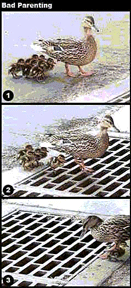mamasnap
Real mamas dishing up sound advice.
Saturday, October 31, 2009
Wednesday, October 28, 2009
Thursday, October 22, 2009
Antibacterial Soap Warning...
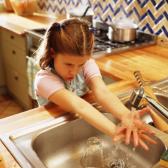 With all the Swine Flu "stuff" going on, I have been keeping Purell and Antibacterial Soap accessible for everyone coming in the door. Because I have decided against getting them vaccinated, I have been slightly psycho about my kids washing their hands every time they come in the front door, or in the car, after shopping, etc.. I was a little alarmed when I came across an article about antibacterial soap in the June 2006 issue of Parents magazine.
With all the Swine Flu "stuff" going on, I have been keeping Purell and Antibacterial Soap accessible for everyone coming in the door. Because I have decided against getting them vaccinated, I have been slightly psycho about my kids washing their hands every time they come in the front door, or in the car, after shopping, etc.. I was a little alarmed when I came across an article about antibacterial soap in the June 2006 issue of Parents magazine.There is an ingredient in some antibacterial soaps called benzalkonium chloride that can cause burns on senisitive skin if left on too long. A little girl had rubbed antibacterial foam soap onto her face and not rinsed it off. The soap dried and stayed on overnight. The next morning her skin was bright red and had broken out in blisters.
She was treated with burn cream and ibuprofen and, luckily, has healed completely.
Because of this article I went straight to the web and googled about antibacterial soaps. What an eye opener! By using these "agents" we not only kill the bad bacterias but the good as well. We are helping the super antibodies to gain strength. It is important for our young ones to build the strongest immune system they can so perhaps we shold let up on the various antibacterial washes, cremes and strong soaps.
Washing with clear running water and REGULAR soap, scrubbing and rinsing for a count of 10, will kill off the bad bacteria and keep us healthy and our immune systems strong.
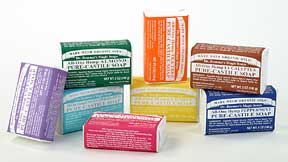 You can use a natural anti-bacterial soap such as
You can use a natural anti-bacterial soap such as Essential Oils Products
• Dr. Bronner Castile Soaps (you can actually get this on amazon.com...weird huh?)
Check out this article for more info (and some interesting reading)
http://www.deliciousorganics.com/Controversies/antibacterial.htm
Wishing you all good health!!!
-SBH
Tuesday, October 20, 2009
Sunday, October 18, 2009
Ken Wants Barbie Back!!!!!!!
Jennifer and Brad, J-Lo and Ben, Barbie and Ken. These are the break ups that really shook us to our very soul. Brace yourself…Ken wants Barbie back!
Ken and Barbie split up a couple years ago and apparently Ken has been longing to win back his plastic paramour ever since. Barbie probably got sick of listening to Madonna and watching old Judy Garland movies.….Apparently Ken has been going to the gym and got a new stylist- so instead of looking like a gay man of the 70’s. 80’s, 90’s and early millennium he looks like a gay man for 2006 and Barbie will hopefully swoon.
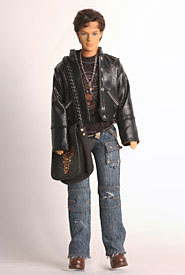
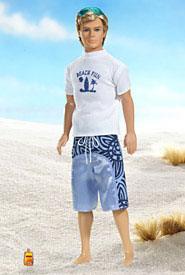
His new look is supposed to be edgy. Ken has two personalities to choose from…
One is the “rugged bad boy” vibe. The other is surfer dude look- who will be a hit with the boys of Ptown.

Look at how Ken has evolved over the years. In the 70’s he was a cross between gay Elvis and gay Starsky. In the 80’s he looked like a gay frat boy. In the 90’s..well he scares me. What straight guy would wear that? 2000’s..see the 90’s comment. A mesh shirt?????
Come on Mattel…Ken is SO gay. Just make him and his alternate personality hook up. That would be so new millennium of you. Ken should realize that his parents will love him no matter what and just come out of the closet.
What is wrong with him being gay anyway?????
Thursday, October 15, 2009
Stranger Danger...Revisited
 The idea of warning kids about 'stranger danger' has become out of favor in recent years, so I may be quoting a bit of old school thought here, but nonetheless I feel it's good to teach the kids that strangers can be dangerous. Fact is many kids are taken by people that they know and there is concern that kids aren't very good at recognizing strangers anyway.
The idea of warning kids about 'stranger danger' has become out of favor in recent years, so I may be quoting a bit of old school thought here, but nonetheless I feel it's good to teach the kids that strangers can be dangerous. Fact is many kids are taken by people that they know and there is concern that kids aren't very good at recognizing strangers anyway.There was a story for example about two years ago about a lost boy scout avoiding searchers because he was worried that they were strangers, which just illustrates another potential stranger danger problem.
According to Vincent Iannelli, M.D. in Pediatrics - a well thought out safety plan in situations when you might get separated from your kids seems a smart way to go. One plan would making sure your kids have some kind of ID (my kids found the current ID bracelets annoying though) with information on how to contact you (we rehearsed our address, phone number and knowing your parents names) having a current picture of your child, a designated meeting place if you become separated, and a discussion of safe places that your child might go if he becomes lost in a crowd (we discussed WHO to go to if lost in a store for instance - ie. a uniformed security guard or someone who works at the store.)
It's somewhat hard to go over ALL this with small kids as they just don't quite get that the world can be a dangerous place, in my experience. So we are adapting our plan as the kids grow older.
 Nonetheless - here's a revisit to recognizing strangers with Desi (our 4 1/2 yr. old) as he's quite a friendly kid:
Nonetheless - here's a revisit to recognizing strangers with Desi (our 4 1/2 yr. old) as he's quite a friendly kid:Mom: What do you do if you are outside and someone you don't know says Hey little boy do you want some candy?
Desi: You say please.
Mom: No, this is someone you don't know, so you say NO, I DON'T KNOW YOU and you run back in the house, ok?
Desi: Ok.
So we rehearse this several times. Next we move on to strangers knocking at the door.
Knock Knock.
Mom: What do you say when someone knocks at the door and you don't know who it is?
Desi: I open it up to say hello.
Mom: No, you say WHO IS IT? If it's someone you know, you can answer the door. If it's someone you don't know - you go get Mommy and Daddy.
Desi: OK.
Knock Knock.
Desi: WHO IS IT?
Mom: It's Fedex with a package.
Desi: Is it for me?
Mom: Desi, no, you're supposed to say - just a minute, let me get my Mom & Dad.
Desi: OK
We rehearse this several times as well complete with knock on the door.
We rehearse what you do if there's an emergency - to call 911. He's got this down pretty good. 911 is to get the police, fireman or ambulance. He knows his address, his phone number and his whole name to tell the 911 person on the phone.
Then Desi revisits the man with the candy outside.
Desi: Do you think he would feel bad if I don't take the candy? (and Desi LOVES candy).
Mom: Oh dear.
So we go over it again.
Such a cute conversation - but problematic with raising friendly, thoughtful kids.
I also really liked this for your kids to see if they can recognize what is a stranger.
- LT
Saturday, October 10, 2009
I've Got Rhythm!

Bouncing your baby on your knee while singing a song is a great calming mechanism, but did you know that it also happens to be how babies learn to dance to the beat for the rest of their lives? Researchers at McMaster University in Ontario have found that music rhythm perception - the ability to hear the beat in music and move in time with it - is developed through experience during the first year of life.
 In their study, they focused on how movement influences auditory development. The first experiment was a 'training session' for a group of 7 mo. old babies in which they listened to a two minute repetition of a rhythm pattern without accented beats. Half the infants were bounced on every second beat and half on every third beat. After the session, the rhythm pattern was played again, this time with accentuated beats. Each baby turned to the song of the rhythm pattern they had just experienced - the second or the third. Researchers concluded that the rhythm of the bouncing they experienced determined which musical pattern they later preferred.
In their study, they focused on how movement influences auditory development. The first experiment was a 'training session' for a group of 7 mo. old babies in which they listened to a two minute repetition of a rhythm pattern without accented beats. Half the infants were bounced on every second beat and half on every third beat. After the session, the rhythm pattern was played again, this time with accentuated beats. Each baby turned to the song of the rhythm pattern they had just experienced - the second or the third. Researchers concluded that the rhythm of the bouncing they experienced determined which musical pattern they later preferred. A second experiment examined whether babies would watch another person bouncing to the beat and develop a preference of their own based on that observation. They did not, which indicates their own body movement was essential for the development of their listening preferences - they had to 'experience' it rather than watch. These studies reveal that there is a strong multisensory connection between our ability to hear rhythms and to move our bodies in time to those rhythms. Integrating these senses - learning to use both the experience of movement and hearing it simultaneously and to let each inform the other - is one of the many essential developmental achievements of the first year of life.
Your baby's delight in being bounced and hearing music is not only fun, but yet another expeience that encourages healthy development!
Source: Science 308 (2005): 1430 (b.a.b.y. magazine)
Friday, October 09, 2009
Snotty boy, snotty girl
 A runny nose might be the result of a cold, allergies, or even spicy foods. Regardless of the cause, a runny nose is usually pretty annoying, if not inconvenient. I came across some home remedies that can be used to treat a runny nose or at least make you fel like maybe you are curing it. Placebo affect? The important thing to remember is that a runny nose is different than nasal congestion and should not be treated with a decongestant unless a doctor recommends it.
A runny nose might be the result of a cold, allergies, or even spicy foods. Regardless of the cause, a runny nose is usually pretty annoying, if not inconvenient. I came across some home remedies that can be used to treat a runny nose or at least make you fel like maybe you are curing it. Placebo affect? The important thing to remember is that a runny nose is different than nasal congestion and should not be treated with a decongestant unless a doctor recommends it.A runny nose is the result of increased mucus production in the sinus and nasal passages. In layman’s terms, a runny nose happens when there is a lot of snot in your nose and it is clearing out of your nasal passages. The increased production of mucus is usually the result of the body attempting to clear cold or flu viruses or irritants and allergens from the body. A normal amount of mucus is always present, lubricating the lining of the nasal passageways and keeping germs out. An increased production typically results in runny, snotty noses and even postnasal drip, both of which can be irritating and cause you to blow your child’d nose anywhere from 5 to 473 times during the course of a day.
 The best relief for a runny nose is to help the body by gently blowing the nose at regular intervals. Trying to get a kid to do this or do it TO your kid can be problematic. AND excessive blowing can irritate the outside of the nose and make it tender and sore. I am a big advocate of Puffs or even the puffs WITH calming Aloe or some other mysterious softening lotion that is somehow in the fibers of tissue. For an excessively runny nose caused by seasonal or environmental allergies, you can try an over the counter antihistamine- but it is always best to check with your pediatrition first. For runny noses caused by cold or flu, an antihistamine may help alleviate the symptom, but because they slow the production of mucus they can cause germs to linger in the nasal “cavity” longer. What I am really focusing on though, is where do I get one of those contraptions that lady has on her head? I want one! It could be useful in so many many situations. Need a wipey? Oh can't get to your bag? Hold on..I have one on my head. Need to pee on the side of the road? Oh, no toilet paper? Well, it just so happens that my hat......And then of course. Shopping with the 2 year old with the oozing nose? No worries! They can help themselves from the comfort of the cart. Moving on.
The best relief for a runny nose is to help the body by gently blowing the nose at regular intervals. Trying to get a kid to do this or do it TO your kid can be problematic. AND excessive blowing can irritate the outside of the nose and make it tender and sore. I am a big advocate of Puffs or even the puffs WITH calming Aloe or some other mysterious softening lotion that is somehow in the fibers of tissue. For an excessively runny nose caused by seasonal or environmental allergies, you can try an over the counter antihistamine- but it is always best to check with your pediatrition first. For runny noses caused by cold or flu, an antihistamine may help alleviate the symptom, but because they slow the production of mucus they can cause germs to linger in the nasal “cavity” longer. What I am really focusing on though, is where do I get one of those contraptions that lady has on her head? I want one! It could be useful in so many many situations. Need a wipey? Oh can't get to your bag? Hold on..I have one on my head. Need to pee on the side of the road? Oh, no toilet paper? Well, it just so happens that my hat......And then of course. Shopping with the 2 year old with the oozing nose? No worries! They can help themselves from the comfort of the cart. Moving on. Give a salty squirt. Over-the-counter saline (saltwater) drops and sprays, such as Ocean, can help flush out irritants that may be causing the nose to run. Some docs say to put the drops in your child's nose, have him lie on his back on the bed, with his head over the edge. Place two drops in each nostril and let them seep in for two to three minutes. Sounds easy huh? Unfortunately there aren’t many kids who are going to let you squirt water up their nose. I would be hard pressed at the ripe age of 40 to let someone squirt anything up my nose...But follow the details of the diagram VERY carefully because who nose what kid of trouble you could get into?It seems the kitchen table could be an EXCELLENT place to administer up the nose basting.
Give a salty squirt. Over-the-counter saline (saltwater) drops and sprays, such as Ocean, can help flush out irritants that may be causing the nose to run. Some docs say to put the drops in your child's nose, have him lie on his back on the bed, with his head over the edge. Place two drops in each nostril and let them seep in for two to three minutes. Sounds easy huh? Unfortunately there aren’t many kids who are going to let you squirt water up their nose. I would be hard pressed at the ripe age of 40 to let someone squirt anything up my nose...But follow the details of the diagram VERY carefully because who nose what kid of trouble you could get into?It seems the kitchen table could be an EXCELLENT place to administer up the nose basting.Suction away those secretions. A baby may have so much excess mucus that it interferes with his breathing and he can't drink or eat comfortably. In this case- time to clear their nose! The fastest way to do this is with a rubber ear bulb, purchased from the drugstore.
Place the baby on his back. Squeeze the bulb, then insert the long, tapered tip in one nostril, and gently release the bulb to suction up the mucus. Withdraw the tip and squeeze the secretions out in a tissue. Repeat with the other nostril. When you're done with the ear bulb, boil it before you use it again. Not only does this work but it is a GREAT way to thoroughly piss off your little one. Make sure you cut their fingernails first.
Use a cool mist humidifier. We use this one a lot at our house and it actually does help. In general, a cool mist vaporizer or humidifier is preferred over a warm mist one because of the risk of your child getting accidentally burned. A cool mist humidifier can be especially helpful for kids that have croup.
Just make sure you keep the machine clean as humidifiers can disperse germs into the air. To minimize this from happening, be sure to follow the manufacturer's directions, and clean your humidifier regularly. Humidifiers can also increase dust mites and mold in your house, and should be avoided if your child has an allergy to dust mites or mold. From experience I would NOT recommend the humidifiers that look like an animal such as an elephant or penguin. My children seem to think it is a fun toy. Ooooo, look at the elephant spew wet smoke everywhere! And it comes apart? Fun!
An easy fix: Prop up the head of the bed. Tuck a strong support under the head of the bed, to elevate it. I have taken books and raised the whole bed. In addition, you can use extra pillows to prop up the child's body even more. The prop should be about 18 inches high. That way, you enlist gravity's help so mucus can drain better. You also help prevent seepage down the back of the throat, which can lead to coughing fits. Telephone books are good.
Fend off cold air with a scarf. If your child's nose drips when she's in cold, windy air, she probably has nonallergic rhinitis, says Lee D. Eisenberg, M.D., assistant professor of otolaryngology at Columbia University College of Physicians and Surgeons in New York City. This is a harmless, common condition that can be remedied by wearing a scarf over the nose to warm the incoming air, he says. My daughter has this and seems to have a runny nose on sunny days occasionally. A fix for this? I have NO idea.
Apple Cider Vinegar. Another natural cure and home remedy for sinus infection is to use Apple Cider Vinegar, which contains potassium. This helps decrease mucus production and have shown to be beneficial as a natural home remedy of sinus infection, runny nose and the common cold. Mix 2 teaspoonfuls of organic Apple Cider Vinegar in a full glass of warm water and drink it up. Do this 3 times a day. I am still trying to figure out how to get my kids to drink this…any ideas?
And then there is the “well duh” solution:
You should also set a goal of drinking around 10 glasses of water everyday. This helps to thin out the mucus which is naturally produced by the body and allows easy drainage through the nasal passages. Besides, if your system is well hydrated it can also help prevent ill health since the body's immune system deteriorates if there is insufficient water in the body. I like to cut up cucumbers and lemons to make a sort of spa water- Healthy and refreshing! Woohoo.
 Is a runny nose serious?
Is a runny nose serious?A runny nose is usually just annoying. But it can be a sign of a more serious problem. See your doctor if:
*Your symptoms last more than two weeks, or you have a fever lasting more than a few days along with your runny nose.
*Your nasal discharge is green in color, and accompanied by sinus pain or fever. This may be a sign of a bacterial infection.
*Your child's nose is persistently runny on one side only. This might be a sign that a small object is lodged in that nostril. Peas, nuts, small action figures…..
*You have blood in your nasal discharge or a persistent clear discharge after a head injury.
*You have asthma or emphysema, or you're taking immune-suppressing medications.
So remember...Puffs...and letssssnot be snotty!.. get it... lets not...let snot...harhar.
But yes, YOU go ahead and be naughty. You probably deserve it.
-SBH
Saturday, October 03, 2009
Bath Toy Scum...blagh
 Whose children like to drink the water out of their rubber bath toys? Ah a show of hands….My kids do…Have you ever squirt the water out and seen the disgustingness that comes out? Gooey grey chunks, slimy scum. Just the kinds of things we want our children to ingest. Yes, bathtub toys DO make bath time go more smoothly, but they also pose a problem. The stuff, which looks like it should be coming from a petri dish instead of a toy your child sucks on, is probably mold. Bath toys are a perfect breeding ground for it. "You have an enclosed space where a few organisms can get in and they don't get out," explains Dr. Lyuba Konopasek, an Assistant Professor of Pediatrics at NewYork-Presbyterian/Weil Cornell Medical Center and mother of two. "It's almost like standing water."
Whose children like to drink the water out of their rubber bath toys? Ah a show of hands….My kids do…Have you ever squirt the water out and seen the disgustingness that comes out? Gooey grey chunks, slimy scum. Just the kinds of things we want our children to ingest. Yes, bathtub toys DO make bath time go more smoothly, but they also pose a problem. The stuff, which looks like it should be coming from a petri dish instead of a toy your child sucks on, is probably mold. Bath toys are a perfect breeding ground for it. "You have an enclosed space where a few organisms can get in and they don't get out," explains Dr. Lyuba Konopasek, an Assistant Professor of Pediatrics at NewYork-Presbyterian/Weil Cornell Medical Center and mother of two. "It's almost like standing water." Don’t freak out….Dr. Paul Williams of Northwest Asthma and Allergy Center and a member of the American Academy of Pediatrics' Section on Allergy and Immunology says, "[Parents] don't need to be worried in the sense that their child's health may be harmed by ordinary quantities of mold in the environment. There are thousands of mold spores in the air that we breathe every day. So, in a lot of ways, molds are just a part of our everyday environment and our system handles it quite nicely."
I know my kids have slurped down plenty of watery yuck despite my repeated warnings to cease and desist. "The likelihood of a child getting sick from this is close to zero," notes Dr. Konopasek. She compares ingesting mold from a bath toy to accidentally giving your child a piece of moldy bread to eat. It's just going to come out when the child goes to the bathroom. Dr. Konopasek adds that the only kids who could potentially be at risk are those who have immune problems, or those younger than three months old.
So while the dampness of the bathroom encourages the growth of mold and mildew, and the use of harsh chemicals can pose risks for your little ones. It's important to clean the toys off in a safe, environmentally friendly way.
 SAFE INGREDIENTS:
SAFE INGREDIENTS:* 2 cups apple cider vinegar (can substitute white vinegar if needed)
* .5L Warm water (filtered is best)
* 2 Foaming denture cleansing tablets- available at drug stores or grandma’s medicine cabinet.
1. Mix vinegar and water in a plastic bucket.
2. Add toys. If they are not covered, add more vinegar and warm water.
3. Weight down floating toys if possible.
4. Soak toys overnight.
5. After toys have soaked, scrub with a bristle cleaning brush.
6. Rinse thoroughly with clean water.
7. If the vinegar soak does not remove all the mold, use another step.
8. Put the toys in another bucket, and cover with warm water.
9. Add denture tablets. Allow to soak overnight.
Most parents would prefer that their children avoid playing with toys that look as if they've been soaking in a cesspool. Dr. Konopasek offers the following tips for cleaning your child's bath time buddies:
* "Try washing plastic toys in a mild dish soap with warm water," suggests Dr. Konopasek. "If it's good enough for my dishes, then it's fine for my kids' toys because they're all going to go in their mouths." Dr. Konopasek is hesitant to advise parents to stick bath toys in the dishwasher. In addition to running the risk of the toys melting, she says, "I'm not a fan of getting hot fluid in there and then possibly squirting out and burning your kid." I have yet to run them through my dishwasher but I do have some in at the moment that I thought I would try. I am REALLY hoping they don’t melt.
* What if you have a toy like a rubber duck with a hole and there's mold growing inside? "You need to throw it out. Once that mold is there, it's time to get a new duck," says Dr. Konopasek. Next time, you might want to stay away from toys with holes. Some people seal up the holes using a glue gun. Smart huh? I’ll have to try it. NOTE: If your toy has a "squeak" mechanism, sealing the hole will also prevent it from squeaking. If you'd prefer not to do that, you will just need to clean the toy again in the future. If you do have the toys with holes try the above “technique” If that doesn’t work then its time to junk them and spend another $9-$16 on new toys. Drag.
* Wash items such as washcloths and terry cloth hand puppets along with your regular laundry at least once a week. If you aren’t doing that anyway………um…….
* Store bath toys where they can drain, such as inside a mesh bag. Avoid keeping toys in buckets or other receptacles where water can collect. Always drain toys between baths. You can make it a game with the kids, a sort of getting out of the bath, cleaning up your toys ritual.
If you want to go the unfriendly way. (Which I am guilty of…I know, hypocrite, but the grody black goo freaks me out) then you can do the following:
 *Mix a solution of bleach water with 1 part bleach to 10 parts water.
*Mix a solution of bleach water with 1 part bleach to 10 parts water.*Add toys to the cleaning solution and allow to sit for 15 minutes. If toys have a hole and the mold is inside the toy, make sure to suck cleaning solution into the toy.
Squeeze the water out of the toys and rinse with clear water (inside and out). When squeezing out the toy, make sure the hole is AWAY from you. I ruined a shirt this morning. Waa.
Allow to dry completely.
Hopefully, we can all conquer the sludge.
Good luck!
-SBH
Wednesday, September 30, 2009
Disciplining Your Toddler
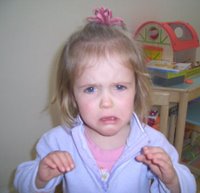 As parents we are filling many shoes- teacher, cook, maid, referee, comforter and chauffeur just to name a few. I think the hardest role is that of the disciplinarian.
As parents we are filling many shoes- teacher, cook, maid, referee, comforter and chauffeur just to name a few. I think the hardest role is that of the disciplinarian.I can’t stand it but, unfortunately, it is something we all have to do.
Apparently, children NEED to be disciplined because they don’t really have the skills to control themselves. They aren’t TRYING to make us crazy- they are just experiencing the world and how they fit into it. They are defining their identity and also seeing what the boundaries are. It is up to us to help them with those boundaries.
There are several methods of discipline that parents use.
#1. Spanking
Spanking doesn’t teach self-control but rather teaches that reacting with violence to things they don’t approve of is okay. I think Spanking is a last resort- when it is perhaps the only way to make the importance of a situation understood.
#2. Time-Outs
I found this very effective with my daughter. I removed her from the situation, told her why she was getting a time out and she had to sit until she quieted down. A time-out isn't really a punishment. It's an opportunity for your child to learn how to cope with frustration and modify his behavior.
#3 Reward method
This is more about complimenting your child when they do good things. Learning through positive feedback. They like praise so it is believed that they will repeat behavior that gets them positive attention. Rewarding the child for good behavior with candy, toys etc.,makes them work for the rewards rather then being motivated from within. This doesn’t actually teach self-control but contributes to wanting the reward. I find the bribery method really effective when I am trying to shop at Target or something. Oh you want this $3 Barbie? Well- if you behave…..worth every penny in my opinion.
#4 Diversion
Getting your kid to focus on something else is sometimes the best way to deal with a situation. Apparently this works best with kids under 3. You don’t have to get angry or act like a police man…you just have to redirect them. Example: your toddler and a friend are fighting over the same toy. You get another one and offer it a and say “Ohh this one looks like fun” or whatever… This sssssort of works with my 3 year old son.....
Whatever methods you use just remember that your child is NOT trying to be a big pain in the butt. They just really don’t know better. There are times when I feel I might explode with frustration and I always try to remind myself of this…
Tuesday, September 15, 2009
Unconditional Parenting
 Interesting article posted in the New York Times today about unconditional parenting. After reading it I see that I do often fall into the category of conditional parenting, meaning that my demonstration of love towards them can be measured by whether they are good or bad. when your child behaves well or does well in school I think that alot of us probably praise and maybe pay more attention- whereas when they behave badly and do poorly in school or a sport, our attitude is different. There are some interesting points made in this article, though I find it hard to figure out just HOW to become an unconditional parent. Yes, I will love my kids no matter what but reacting to negative behavior.....well.....what is one to do? Listen to Enya and meditate together to remove the "bad"or "weak" energy???? I do my best to let them know that even when they aren't the best or fall short of their own expectations I still love them. I want them to be secure in who they are. The article says to "explain reasons for requests, maximizing opportunities for the child to participate in making decisions, being encouraging without manipulating, and actively imagining how things look from the child’s point of view." I always try to see it from their point of view and give them an element of control. I just don't understand how one can NOT be conditional about some things sometimes. I am having a hell of a time getting my daughter to do her homework. It's like puling teeth and I end up losing my patience after a while. HOW can this be solved without some kind of balance of some sort? Your teacher will not be happy if, It makes me angry when.....Unconditional parenting? I WISH I was that evolved! Check it out-
Interesting article posted in the New York Times today about unconditional parenting. After reading it I see that I do often fall into the category of conditional parenting, meaning that my demonstration of love towards them can be measured by whether they are good or bad. when your child behaves well or does well in school I think that alot of us probably praise and maybe pay more attention- whereas when they behave badly and do poorly in school or a sport, our attitude is different. There are some interesting points made in this article, though I find it hard to figure out just HOW to become an unconditional parent. Yes, I will love my kids no matter what but reacting to negative behavior.....well.....what is one to do? Listen to Enya and meditate together to remove the "bad"or "weak" energy???? I do my best to let them know that even when they aren't the best or fall short of their own expectations I still love them. I want them to be secure in who they are. The article says to "explain reasons for requests, maximizing opportunities for the child to participate in making decisions, being encouraging without manipulating, and actively imagining how things look from the child’s point of view." I always try to see it from their point of view and give them an element of control. I just don't understand how one can NOT be conditional about some things sometimes. I am having a hell of a time getting my daughter to do her homework. It's like puling teeth and I end up losing my patience after a while. HOW can this be solved without some kind of balance of some sort? Your teacher will not be happy if, It makes me angry when.....Unconditional parenting? I WISH I was that evolved! Check it out-http://www.nytimes.com/2009/09/15/health/15mind.html?emc=eta1
New York Times HEALTH | September 15, 2009
Mind: When a Parent's 'I Love You' Means 'Do as I Say'
By ALFIE KOHN
Evidence is now available about the mainstream thinking on the disciplining of children.
-SBH
Thursday, September 10, 2009
Eat it or Toss it???
 Sometimes it's easy to tell when things are past their prime. Socks smell, flowers wilt and movie stars look more stretched than sexy.
Sometimes it's easy to tell when things are past their prime. Socks smell, flowers wilt and movie stars look more stretched than sexy. But what about the spaghetti leftovers from last week, or that days-past-its-sell-by-date container of yogurt in the fridge? Do you dare dive in?
StillTasty.com, the ultimate shelf-life guide, has the answers. (No and probably, respectively.)
Type the name of the food into the Keep It or Toss It search engine and you'll find out how long it can be kept in the pantry, refrigerator and freezer. The site also provides tips for the best ways to store each type of food.
While you're online, browse through StillTasty's article and Q&A archives, or submit a question of your own.
It's a quick way to be safe, not sorry.
Get the scoop at www.StillTasty.com.
Courtesy of Food Now!
-SBH
Wednesday, July 15, 2009
Sunscreen
 Summer is in full swing. The sun is shining high in the sky, pools and beaches are calling to us to come out and play. But Susan Bayliss, MD, director of pediatric dermatology at St. Louis Children's Hospital, reminds parents that there is one essential item for every family to have nearby for the summer months: sunscreen. "Because 80 percent of sun damage to the skin occurs before 18 years of age, it is very important to protect our children from harmful ultraviolet rays," she says.
Summer is in full swing. The sun is shining high in the sky, pools and beaches are calling to us to come out and play. But Susan Bayliss, MD, director of pediatric dermatology at St. Louis Children's Hospital, reminds parents that there is one essential item for every family to have nearby for the summer months: sunscreen. "Because 80 percent of sun damage to the skin occurs before 18 years of age, it is very important to protect our children from harmful ultraviolet rays," she says.We all need some sun exposure; it's our primary source of vitamin D, which helps us absorb calcium for stronger, healthier bones. But it doesn't take much time in the sun for most people to get the vitamin D they need, and unprotected exposure to the sun's ultraviolet rays can cause skin damage, eye damage, immune system suppression, and even cancer. Even people in their 20s can develop skin cancer.
Most children rack up between 50% and 80% of their lifetime sun exposure before age 18, so it's important that parents teach their children how to enjoy fun in the sun safely. With the right precautions, you can greatly reduce your child's chance of developing skin cancer.
A good start is avoiding prolonged exposure to the sun between the peak hours of 10 a.m. and 3 p.m. That doesn't mean you have to keep children indoors — but take breaks from sun exposure during those hours, and make sure children wear sun protection when they are in the sun.
 Slather it On
Slather it OnSunscreens that block both UVA and UVB light with a minimum sun protection factor (SPF) of 15 should be applied liberally, especially to the face, ears, neck and backs of the hands. "People with fair skin, light eyes and blond or red hair should wear sunscreen year-round," Dr. Bayliss says. Sunscreen should be reapplied every three to four hours.
Parents who choose waterproof sunscreen for their kids should remember that it only lasts for 30 minutes in the water, so it needs to be reapplied more often. Zinc oxide can be used on sensitive areas like the nose and shoulders to provide a complete sun block.
Check Expiration Dates
Before you rely on any type of sunscreen, remember that it does expire, especially after being exposed to the heat of the sun or the high temperatures of the car. "I suggest parents buy sunscreens fresh each summer," Dr. Bayliss says.
Keep the Very Little Ones Out of the Sun
"Sunscreens have not been tested on babies under 6 months," Dr. Bayliss says. "Babies need to be in the shade and covered with clothing." Dr. Bayliss advises parents to use sunscreen on babies only if sun exposure is unavoidable and only in addition to clothing.
The American Academy of Pediatrics now states that sunscreen is probably safe to use on younger children, as young as six months, especially if you just use it on small areas of your baby's skin that is exposed to the sun and not protected by clothing, such as the infant's hands and face.
But babies, especially those with fair skin, should not be out in the sun that long. “Parents should definitely avoid putting their babies to sleep in the sun," Bayliss says.
Still, younger children should be kept out of direct sunlight because they can burn easily and may not be able to handle getting overheated as well as older children. So even though it is likely safe to use sunscreen on kids less than six months old, it is safer to keep them out of the sun.
Don’t Let the Clouds Fool You
Dr. Bayliss also reminds parents to be just as cautious on cloudy days. Because as much as 80 percent of the sun's ultraviolet radiation can get through the clouds, they offer little protection for sunburn. Plus, beachcombers must remember that sand and water reflect sunlight and can contribute to sunburn. In addition to sunscreen, children should wear hats and sunglasses.
And, before you head off to that sunny vacation, Dr. Bayliss tells parents to check with their pediatrician to determine whether any medicines their child takes can increase sensitivity to the sun.
 Other tips to keep your kids safe from the sun:
Other tips to keep your kids safe from the sun:When buying sunscreen look for:
the the highest SPF you can find, typically 50+, though some experts believe that they don't provide that much extra protection. Some experts go as far as to say the SPF rating should be capped at 30.
a kids' brand (Banana Boat Kids, Coppertone Kids, Coppertone Waterbabies, etc.)
While it is fine to use these, they are really not that much different from those that are made for adults, so you don't really have to buy a separate sunscreen just for your kids.Apply enough sunscreen to protect your child. Most experts estimate that many parents only use about half of the recommended amount of sunscreen on their children, providing less protection than they think.
a sunscreen that is water resistant. Even if you aren't going swimming, if your child is outside, he will likely be sweating, so a water resistant might provide better protection than a regular sunscreen. Be sure to reapply sunscreen regularly and at least every 2 hours, or more often if your child is swimming or sweating.
hypoallergenic and fragrance free, especially if your child has sensitive skin.
a form that is easy to use on your child, whether that means it is a gel, lotion, spray, continuous spray, etc.
Remember to apply sunscreen at least 30 minutes before your child will be exposed to the sun.
Use sunscreen even if it is cloudy outside. Clouds don't absorb all of the UV radiation that may harm your child.
Avoid sun exposure when the effects of the sun are the strongest, which is usually from about 10 a.m. to 4 p.m.
Use physical protection, including clothing, such a hat with a 3-inch brim, lightweight long pants and long-sleeved shirts, and/or a stroller, tent, umbrella or tree.
Encourage your children to wear sunglasses that protect against ultraviolet rays.
Remember that a sunscreen isn't better just because it is more expensive. Saying this, I buy La Roche Posay Anthelios SX sunscreen for my children's faces. Overpriced and available at CVS. BUT, it IS a french product and I really do trust those Euro brands. It is a daily moisturizer containing Mexoryl™ SX, a unique organic UV filter that is highly protective against short UVA waves, provides comprehensive UVA/UVB protection*. Anthelios SX features the first new sun filter in a sunscreen approved by the FDA in 18 years.
For more information about Anthelios SX, Mexoryl SX and UV rays, please visit Anthelios.com.
Broad Spectrum Sunscreens
Unfortunately, many sunscreens that say that they are broad spectrum really aren't or don't block rays from the full UVA spectrum. To get good protection from UVA rays, look for sunscreens that list avobenzone, titanium dioxide, or zinc oxide as ingredients.
Sunscreen Ingredients
If your child gets a rash from his sunscreen, you might review the ingredient's list and choose a different one next time. Make sure to choose one that is PABA free. You might also look for one that gets its UVA protection from a sunblock, such as titanium dioxide or zinc oxide, since they can be less irritating than avobenzone, a common sunscreen ingredient.
Be sure to apply it to just a small area of your child's skin if you think he might have a reaction to the new sunscreen too.
 Unprotected sun exposure is even more dangerous for kids with:
Unprotected sun exposure is even more dangerous for kids with:moles on their skin (or whose parents have a tendency to develop moles)
very fair skin and hair
a family history of skin cancer, including melanoma
You should be especially careful about sun protection if your child has one or more of these high-risk characteristics.
So before you send your kids outside to play in the sun- just make sure you take the necessary precautions when it comes to sun exposure! AND don't forget to slather YOURSELF- everywhere I missed a spot the other day and the burn STILL hurts. Don'y you hate it when that happens??
-SBH
Tuesday, July 14, 2009
Music is good for the soul
 Who would've guessed that reggae or Brahms could be good for your baby's soul? Music that soothes you or makes you happy just might have the same effect on your baby. Although there's evidence that music has cognitive benefits for preschoolers and older children, no one has studied this in infants. Still, you may find that music plays a useful role in your baby's life now in other ways:
Who would've guessed that reggae or Brahms could be good for your baby's soul? Music that soothes you or makes you happy just might have the same effect on your baby. Although there's evidence that music has cognitive benefits for preschoolers and older children, no one has studied this in infants. Still, you may find that music plays a useful role in your baby's life now in other ways:Music as a soother. Works for you, doesn't it? When your baby is fussy or crying, try singing lullabies softly into her ear, like "Hush Little Baby" or "Twinkle, Twinkle Little Star." The repetitive sounds and your familiar voice may help her to feel more secure and relaxed.
Music as calming background noise. Instead of keeping the TV or radio on all day, consider switching to an all-music radio station you like. Or, if you have one, program your iPod with tunes that please both you and your baby.
Music as a source of strength. A study at Brigham Young University found that premature infants who were exposed to music gained more weight, had lower blood pressure, and had a stronger heartbeat than a comparable group of babies who weren't.
There's no evidence that any one kind of music is more effective than another, so pick what you like. Exception: Animal and plant studies show that the discordant notes and chaotic pace of rap, grunge, and head-banger rock seem to interfere with growth in both plants and animals and with brain structure in animals.
courtesy of Babycenter.com
Monday, July 13, 2009
The Eight Foods You NEED To Eat
 8 Superfoods
8 Superfoods By Jonny Bowden, PhD, CNS
Blueberries
These amazing berries are on anyone's list of super foods. Recent research shows that they're brain food -- feeding blueberries to rats actually slows their age-related mental decline. Blueberries contain pterostilbene, a plant compound recently shown to have cholesterol-lowering properties. Their ORAC value (antioxidant rating) is the highest of any fruit. And blueberries are rich in fiber. Tip: Try them frozen. They taste like sherbet!
Guava
Among the super foods of the world, guava is a sleeper. With a taste that's been described as "part strawberry and part pear," one low-calorie cup of this vitamin rich fruit contains a whopping 8 grams of fiber. And in one widely used test of antioxidant power, guava scored only second to blueberries, right behind kale. Guava also contains cancer-fighting lycopene.
Kale
Kale is a member of the brassica family -- vegetable royalty that boasts cabbage and broccoli among its relatives. It's rich in potent cancer-fighting substances called indoles, and loaded with bone-building vitamin K. Kale has the highest antioxidant rating of any vegetable and is ridiculously low in calories. Try it tossed with olive oil, a few dried cranberries and some pine nuts.
 Sardines
SardinesThe best kept secret in the world when it comes to health foods and the secret weapon of travelers looking for a cheap, portable, easily available source of protein. Sardines are rich in omega-3 fats, and one of the least contaminated of any seafood since they rank so low on the food chain. Eat them out of the can or throw them on some salad.
Apples
The juicy red or green apple's reputation for keeping you out of the doctor's office is well deserved. Loaded with pectin (an important fiber), apples are one of the best sources of boron, a little known nutrient that helps support strong and healthy bones. An apple with a glass of water is a great natural appetite suppressant. Highest antioxidant value: Red Delicious.
Coconut Oil
This superb oil has been long neglected as a healthy oil because it contains saturated fat. But not to worry: the saturated fat in coconut is a very healthy kind called MCT (medium chain triglyecerides) which is easily burned by the body for energy. Coconut oil also contains lauric acid, a natural anti-viral and anti-microbal. And today's excellent virgin coconut oil -- unlike the inferior products of a few decades ago -- doesn't contain trans fats.
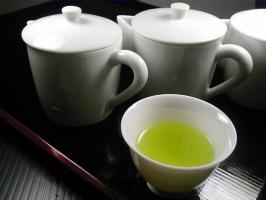 Green Tea
Green TeaA superstar beverage if there ever was one, green tea helps with weight loss and helps fight against cancer. It contains EGCG, a catechin (plant compound) which stimulates metabolism and has anti-cancer properties to boot. Green tea also contains theanine, a natural relaxant which helps explain why the caffeine in green tea doesn't make you nearly as jittery as coffee.
Flaxseeds
Flaxseed oil is one of the only plant sources of omega-3 fats, but the flaxseeds themselves provide the added benefit of fiber along with omega-3. Flaxseeds can be thrown on salads, tossed into smoothies, or sprinkled on vegetables. They also contain lignans, a group of plant nutrients that have been studied by the National Cancer Institute for their cancer preventive properties.
-SBH
Friday, July 10, 2009
Raynaud's Syndrome
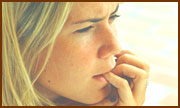 As if my pregancy wasn't bad enough... I had a really awful time breast feeding. It at one point was incredibly painful. My nipples were cracked and bled. I felt a sense of dread and anxiety everytime I had to feed my baby but was determined to breast feed for the first year of his life. THEN, when I was done feeding him, I would get a searing pain that moved across my chest that would last for up to an hour.
As if my pregancy wasn't bad enough... I had a really awful time breast feeding. It at one point was incredibly painful. My nipples were cracked and bled. I felt a sense of dread and anxiety everytime I had to feed my baby but was determined to breast feed for the first year of his life. THEN, when I was done feeding him, I would get a searing pain that moved across my chest that would last for up to an hour. One day after a good cry, I decided to consult a lactation specialist. I saw her learned that #1. My baby had a bad latch and #2 I had Raynaud's Syndrome.
Oh great, something else to worry about....but actually it wasn't that bad and seems to be very treatable. I was just relieved that there was a reason for my pain and that I was not a TOTAL failure as a breastfeeder.
So what is Reynaud's?
Here is part of a great article I found about it.
"Raynaud's phenomenon is due to spasm of blood vessels preventing blood from getting to a particular area of the body. It occurs in response to a drop in temperature. Most commonly, Raynaud's phenomenon will occur in the fingers, typically when someone goes outside from a warm house on a cool day. The fingers will turn white and the lack of blood getting to the tips of the fingers will cause pain. Raynaud's phenomenon occurs more commonly in women than men, and is often associated with illnesses such as rheumatoid arthritis.
Raynaud's phenomenon can also occur in nipples. In fact, it is much more common than generally believed. It can occur along with any cause of sore nipples, is, in fact, probably a result of damage, but it may also, on occasion, occur without any other kind of nipple pain at all.
Typically, Raynaud's phenomenon occurs after the feeding is over, once the baby is already off the breast. Presumably, the outside air is cooler than the inside of the baby's mouth. When the baby comes off the breast, the nipple is its usual colour, but soon, within minutes or even seconds, the nipple will start to turn white. Mothers generally describe a burning pain when the nipple turns white. After turning white for a while, the nipple may actually turn back to its normal colour (as blood starts to flow back to the nipple), and the mother will notice a throbbing pain. The nipple may go back and forth between colours (and types of pain) for several minutes or even an hour or two."
For more go to :
http://www.asklenore.info/breastfeeding/raynaud.html
The loss of color in the nipple is called "blanching". When you first feel the pain in your breast look and see if the nipple looses its color. It seems that everytime the pain gets bad this happens- from MY own experience. Poor positioning and poor attachment or latch may cause blanching of the nipple and pain during breastfeeding. I also read that because the breast pain associated with Raynaud's phenomenon is so severe and throbbing, it is often mistaken for Candida albicans infection.
Hopefully, no one will go for as long as I did. I spent almost 7 weeks in just the WORST pain. So I hope this helps some of you!!!! Thankfully, I made it to 14 months of breastfeeding!
-SBH
Wednesday, July 08, 2009
Childproof Those Pretty Pills
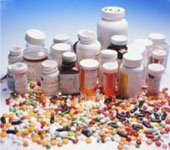 Have you noticed how your kid puts everything, or least almost everything, they find into their mouths? Curious 2-4 year olds can get themselves into big trouble with medications, especially because they come in such pretty colors and can be shiny or even have TWO colors. Beware of the dangers lurking in your cabinets and the dark recesses of your purse. Try to make every effort to store all medications away from those little prying explorers.
Have you noticed how your kid puts everything, or least almost everything, they find into their mouths? Curious 2-4 year olds can get themselves into big trouble with medications, especially because they come in such pretty colors and can be shiny or even have TWO colors. Beware of the dangers lurking in your cabinets and the dark recesses of your purse. Try to make every effort to store all medications away from those little prying explorers. Here is the CDC's advice on the safe storage of medicines and vitamins:
* Post the national phone number for the poison control center on or near every home phone. That phone number is 800-222-1222.
* Store all medicines in secured cabinets out of reach of children.
* Use child-resistant caps and always close medication lids tightly after use.
* Remember, child-resistant containers aren't childproof. Store them in a secured cabinet.
* Whenever possible, store medicines in their original containers.
* If you transfer medication to a pill box or other container that isn't childproof, take extra precautions to keep them away from kids.
* Get rid of leftover or expired medicines by flushing them down a toilet.
* Avoid taking medicines in front of children, who tend to imitate adults.
* Never call medicine "candy."
* Be aware of any medicines visitors bring into the home. Keep visitors' drugs secure and away from kids. Don't leave those medicines in an unattended purse or suitcase.
SOURCES: CDC, Morbidity and Mortality Weekly Report, Jan. 13, 2006; vol 55: pp 1-5. News release, CDC.
-SBH


